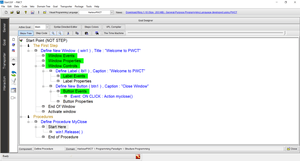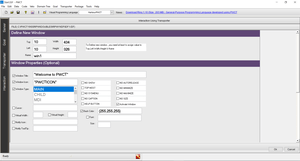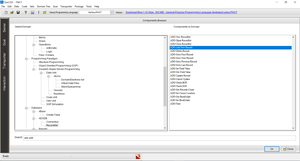PWCT (software)
PWCT is a free open source visual programming language for software development.[1][2][3] [4]
 | |
| Paradigm | Multi-paradigm: Visual Programming, imperative, procedural, object-oriented |
|---|---|
| Designed by | Mahmoud Samir Fayed |
| Developer | The PWCT Development Team |
| First appeared | December 26, 2005 |
| Stable release | 1.9
/ February 12, 2020 |
| Implementation language | Visual FoxPro |
| OS | Microsoft Windows |
| License | GNU General Public License |
| Filename extensions | .ssf |
| Website | http://pwct.org |
Goal
The vast majority of computer owners are only users, and only a fraction develop software themselves. Programming has the image that it is difficult. One of the many initiatives to remove that image is Programming Without Coding Technology (PWCT). Although visual programming environments are generally limited in their capabilities and mainly aim to show the user the concepts of programming, one can build almost anything with PWCT. [5][6][7] PWCT can also be useful for introducing programming concepts. The project was founded in December 2005 and supports designing applications through visual programming then generating the source code. The software supports code generation in many programming languages.[8][9][10][11]
History

- PWCT was registered on Sourceforge in December 2005
- PWCT 1.0 was released on 18 October 2008
- PWCT 1.1 was released on 20 February 2009
- PWCT 1.2 was released on 4 May 2009
- PWCT 1.3 was released on 30 May 2009
- PWCT 1.4 was released on 28 August 2009
- PWCT 1.5 was released on 27 March 2010
- PWCT 1.6 was released on 16 May 2010
- PWCT 1.7 was released on 15 September 2010
- PWCT 1.8 was released on 18 October 2011 (Last update : 22 April 2013)
- PWCT 1.9 was released on 7 May 2013 (Latest update : 12 February 2020)
Concept


The visual source inside PWCT is designed using the Goal Designer where the programmer can generate the steps tree through the interaction with the visual language components.
Inside PWCT, the visual source is a collection of goals, each goal contains tree of steps and each step/node inside the steps tree may contain one or more of data entry forms. Steps tree uses colors that tell the programmer about the step type. Some steps allow containing sub steps, other steps don’t allow this, also some steps are not more than comments for the programmer. The steps tree gives the programmer two dimensions where the relationship between the node and another node could be “next to” or “contains” where the programmer can go depth-first or breadth-first when he/she interacts with the steps tree.
The programmer can use the dimension "contains" to do an operation on a group of steps/nodes at the same time (move up / move down / cut/ copy / delete).
The programmer can use the form designer to design the user interface.
The programmer can use the time dimension where he/she can know when each step is created (Date & Time) and can move along the time dimension to see only the steps at any point during the development process.
Inside the Goal Designer, the user can use the mouse or the keyboard to select the visual components and generate new steps in the steps tree. Using the mouse we can explore the environment to see the components that are ready for use. Using the Keyboard by typing the component name, the programmer can quickly get any component and start using it.
Features
- General Purpose.
- Visual Programming (More than one dimension, No Syntax Errors, Time Dimension and Colors).
- Visual Editor (Keyboard shortcuts, Customization, Cut, Copy, Paste, Search and Replace)
- Syntax Directed Editor (Avoid Errors).
- Free Editor and VPL Compiler.
- The programmer can see and edit the generated source code.
- The programmer can change the step name and the steps colors.
- Support code generation in C, Python, C#, Harbour and Supernova programming languages.
- The programmer can play programs as movie to learn how to create the program step by step
- Don't force a programming paradigm.
- Extension (Create new components).
- Run programs at any point in the past during the development process.
Visual Languages
The PWCT visual programming language components are classified into the next categories
- CPWCT : Visual Components that generate source code in the C programming language.
- PythonPWCT : Visual Components that generate source code in the Python programming language.
- HarbourPWCT : Visual Components that generate source code in the Harbour programming language.
- SupernovaPWCT : Visual Components that generate source code in the Supernova programming language.
- C#PWCT : Visual Components that generate source code in the C# programming language.
See also
References
- Andrei Fercalo (11 March 2014). "Programming without coding technology review". Softpedia.
- Hend Al-Khalifa (29 February 2008). "Free Open Source Visual Programming Language". Al Riyadh.
- Mones Hawas (23 November 2016). "Developing Programming Without Coding Technology 2.0". youm7.com. youm7.
- MUTHA, ABHISHEK A (September 2015). "This Month's DVD Contents - Electronics For You Magazine" (PDF). EFY Group.
- Computer Total Magazine (7 October 2018). "Free software: the best freeware from October 2018 - Includes (You can make almost anything with PWCT)". Computer!Totaal.
- AL-AALEM Magazine (November 2008). "Programming Without Coding Technology Review" (PDF). AL-AALEM the Scientists Magazine, Issue No. 116, Pages 26-27 Deposit number 18/0157. ISSN 1319-6545.
- Chin, Jerry M. et all (2013). "A String Search Marketing Application Using Visual Programming" (PDF). e-Journal of Business Education and Scholarship of Teaching.
- Khaled Almesahuge (17 June 2010). "Useful open source projects - Programming Without Coding Technology". Al Riyadh.
- Naglaa Elsayed (2009). "Programming Without Coding Technology - Innovative Project (offline source)" (PDF). Al Gomhuria.
- Mones Hawas (29 May 2018). "Progress in developing PWCT 2.0". youm7.com. youm7.
- Sourceforge Team (27 April 2018). "Top 5 Education Software of the Week". sourceforge.
Further reading
- Fayed, Al-Qurishi, Alamri, Aldariseh (2017) PWCT: visual language for IoT and cloud computing applications and systems, ACM
- Fayed (2017) General-Purpose Visual Language and Information System with Case-Studies in Developing Business Applications, King Saud University
- Fayed (2013) Using C#.NET through Programming Without Coding Technology, Code Project
- Fayed (2013) Using Python inside Programming Without Coding Technology, Code Project
- Fayed (2013) The Time Machine and the PWCT Visual Programming Language, Code Project